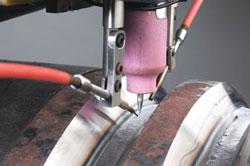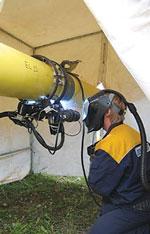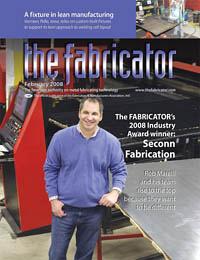Contributing Writer
- FMA
- The Fabricator
- FABTECH
- Canadian Metalworking
Categories
- Additive Manufacturing
- Aluminum Welding
- Arc Welding
- Assembly and Joining
- Automation and Robotics
- Bending and Forming
- Consumables
- Cutting and Weld Prep
- Electric Vehicles
- En Español
- Finishing
- Hydroforming
- Laser Cutting
- Laser Welding
- Machining
- Manufacturing Software
- Materials Handling
- Metals/Materials
- Oxyfuel Cutting
- Plasma Cutting
- Power Tools
- Punching and Other Holemaking
- Roll Forming
- Safety
- Sawing
- Shearing
- Shop Management
- Testing and Measuring
- Tube and Pipe Fabrication
- Tube and Pipe Production
- Waterjet Cutting
Industry Directory
Webcasts
Podcasts
FAB 40
Advertise
Subscribe
Account Login
Search
Welding more with less
New technologies take a comprehensive approach to orbital welding operations
- By Michael Bishop
- February 12, 2008
- Article
- Tube and Pipe Fabrication

Orbital welding systems complete multiple passes in a continuous arc without variations or mistakes, providing a consistent weld.
Oil and gas is one of the key industries requiring extensive pipe welding—transmission and production activity in the industry is forecast to increase this year. Meanwhile the number of skilled welders is projected to decrease. With the gap between new projects and available welders only expected to widen, welding companies have to make up the difference by using machines that can compensate for the labor shortage and maximize the productivity of available welders. New developments in orbital welding technology are helping companies address these tasks.
According to John Emmerson, president of Magnatech Limited Partnership, East Granby, Conn., three distinct orbital welding technologies currently are used: fusion-only welding for thin-wall tubes and pipes, multipass gas tungsten arc welding (GTAW) for process and pressure piping, and orbital multipass flux-cored arc welding (FCAW) for heavy-wall, large-diameter pipes.
The chief advantage of multipass systems is their ability to increase a welder's duty cycle by up to 300 percent, Emmerson said. In manual pipe welding applications, a welder may have to move around the pipe and switch positions several times, starting and stopping repeatedly. An orbital system, however, can weld multiple passes without breaking the arc. It repeats programmed values without variations or mistakes, minimizing the number of defects. Faster than manual shielded metal arc welding (SMAW), orbital multipass FCAW deposits about 8.0 pounds of weld metal per hour, Emmerson said.
Taking into account the skilled-welder shortage, exactly how is orbital welding equipment helping companies finish projects?
"I believe that the new orbital welding technologies can, in their simplest form, minimize the need for highly skilled welders," Emmerson said. "For the more complex, multipass processes, they can greatly augment the productivity of a manual welder."
Orbital Welding: The Next Generation
Orbital welding equipment now incorporates production monitoring and analysis capabilities. Lou Lantieri, vice president of sales and marketing for Astro Arc Polysoude Inc., Valencia, Calif., said more welding companies are paying attention to process variables.
"There's more of an emphasis now on a total solution to welding the pipe together, rather than taking older, existing manual methods and getting everything ready and trying to adapt a piece of automation into it," Lantieri said. "In other words, preparation and things like that are becoming more automated so that the repeatability is not just in the weld process, it's also in the fit-up and the joint designs."
The equipment provides the welder with instant access to information using the microprocessor's memory and calculation capability, Emmerson explained. Many machines have a quality control program that allows supervisory personnel to preset limits for each parameter; after the weld, the user can obtain a printout stating whether or not the weld was made within the limits. The welder then can store the information in onboard memory and download it later. USB capability allows suppliers to download information, transfer programs, and store quality control information using a USB key.
Data logging preserves vital process information by monitoring amps, volts, travel speed, wire speed, and gas flow, and then recording the data in milliseconds for the entire run.
"For the first time, this allows welding to be treated similarly to many other manufacturing processes, where extensive data can be taken and statistically analyzed by QC personnel to observe trends that might affect weld quality [and] equipment maintenance issues," Emmerson said.

Recent orbital technology monitors several welding parameters simultaneously and records the data for the entire run.
The key development in FCAW is not that new systems necessarily are superior to previous generations, but that orbital FCAW is gaining much more acceptance, according to Emmerson. Although the process was approved several years ago for critical pipe welds in the nuclear industry, U.S. companies are just beginning to use it for power plant piping on materials such as P-91. Earlier equipment used to orbital-weld pipeline typically utilized solid-wire gas metal arc welding (GMAW), but the process since has become less popular because of a high defect and repair rate, according to Emmerson. With pipeline companies now requiring stricter quality standards, FCAW has overcome GMAW as the preferred method, he said.
New orbital fusion welding equipment also incorporates automatic program generation. The welder inputs the material, diameter, and wall thickness; the machine then uses the data to generate the welding program.
"This is a big leap forward because the most serious problem that orbital welding equipment manufacturers have always had [during training] is how to teach a welder how to program," Emmerson said. "For example, even the most skilled welder may be at a loss to determine torch rotation speed based upon his years of experience."
Simplifying the Operation
Although orbital welding suppliers engineer new equipment to be highly technical and precise, they also have taken steps to simplify its use.
"There's more technology available for finding the center of the joint," Lantieri said. "In other words, instead of having a person always steer everything accurately, now the machine itself can find the center of the joint and it can better track itself. So there's slightly less operator interface."
New equipment includes intuitive power supplies that diagnose and display problems, informing the welder of the corrective steps needed to resume operation. If a gas bottle runs out, for example, then the system may display a message and requesting an inspection of the supply and lines. Older technologies might prevent welding operations, but require the welder to diagnose the problem.
With this technology, welders can input programming notes into a specific weld program. This allows them to reference application-specific material requirements—filler wire alloys, preheat instructions, and other variables—for subsequent operations.
Arc gap, an important factor on simple fusion heads, is established by the tube diameter and the length of the tungsten used for a particular weld head size; consequently, the welder must cut the tungsten to an exact length to ensure suitable arc length. New machines display the correct tungsten cut length, whereas older equipment would have required a series of calculations.
Three other features of new orbital equipment also help simplify operation. The welding machines—utilizing inverter power supplies—are more compact and lightweight than previous generations, easier for welders to move around a job site, and better-suited to confined spaces. Sealed, waterproof remote-control pendants enhance equipment durability. Password protection prevents unauthorized changes to weld programs and parameters.
Time to Multitask
How should suppliers continue to advance orbital welding technology to meet the needs of welders, address the labor shortage, and help fabricators take on more projects? What developments would make the most sense? Lantieri believes equipment manufacturers will take more of an integrated approach, tackling projects that require automation and machines that combine preparation and welding operations into a comprehensive tool.
"In summary, over the years—and I've been doing this for about 35 years now—it used to [involve] everybody expecting the welding machine by itself to solve the welding problems," Lantieri said. "And I think what people are realizing and taking advantage of now are the total solutions, from cradle to grave. So you machine everything with precision, you fit everything up with precision, and then you weld it with precision."
About the Author

Related Companies
subscribe now

The Fabricator is North America's leading magazine for the metal forming and fabricating industry. The magazine delivers the news, technical articles, and case histories that enable fabricators to do their jobs more efficiently. The Fabricator has served the industry since 1970.
start your free subscription- Stay connected from anywhere

Easily access valuable industry resources now with full access to the digital edition of The Fabricator.

Easily access valuable industry resources now with full access to the digital edition of The Welder.

Easily access valuable industry resources now with full access to the digital edition of The Tube and Pipe Journal.
- Podcasting
- Podcast:
- The Fabricator Podcast
- Published:
- 04/16/2024
- Running Time:
- 63:29
In this episode of The Fabricator Podcast, Caleb Chamberlain, co-founder and CEO of OSH Cut, discusses his company’s...
- Trending Articles
AI, machine learning, and the future of metal fabrication

Employee ownership: The best way to ensure engagement

Steel industry reacts to Nucor’s new weekly published HRC price

How to set a press brake backgauge manually

Capturing, recording equipment inspection data for FMEA

- Industry Events
16th Annual Safety Conference
- April 30 - May 1, 2024
- Elgin,
Pipe and Tube Conference
- May 21 - 22, 2024
- Omaha, NE
World-Class Roll Forming Workshop
- June 5 - 6, 2024
- Louisville, KY
Advanced Laser Application Workshop
- June 25 - 27, 2024
- Novi, MI



























